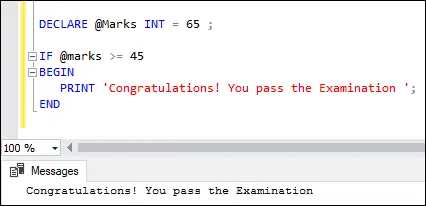Stavek IF je del funkcije nadzornega toka v strežniku SQL Server. Običajno je to izjava o odločanju v različnih programskih jezikih, ki vrne vrednost na podlagi danih pogojev . Ta stavek izvede kodo, zapisano v bloku IF, ko je podani pogoj ovrednoten kot resničen, in ko je pogoj ovrednoten kot false, se bo izvedel stavek ELSE.
Izjava IF
Sledi sintaksa, ki ponazarja uporabo tega stavka v SQL Serverju:
IF boolean_expression BEGIN { statement_block } END V zgornji sintaksi je blok_izjave v ZAČETEK...KONEC blok se izvede, ko logični_izraz je s stanjem zadovoljen. V nasprotnem primeru se ta blok preskoči in krmilnik programa se premakne v stavek za KONEC ključna beseda. Vedeti moramo, da če izraz vsebuje a IZBERI izjava, moramo zapiši jih v oklepaj .
Primer
Oglejmo si primer za razumevanje stavka IF brez bloka ELSE. Spodnji primer bo prikazal rezultat, ko bo pogoj izpolnjen. V nasprotnem primeru se programski nadzor premakne v stavek za ključno besedo END, če obstaja.
DECLARE @Marks INT = 65 ; IF @marks >= 45 BEGIN PRINT 'Congratulations! You pass the Examination'; END
Izvedba izjave bo dala spodnji rezultat:

Zdaj bomo to prikazali na spodnjem ' študent' tabela z naslednjimi podatki:

Spodaj je še en primer, ki dobi skupne ocene izbranega študenta iz ' študent' tabelo v vzorčni bazi podatkov in nato natisne a sporočilo če je več kot 400 .
BEGIN DECLARE @Total_Marks INT; SELECT @Total_Marks = total_marks FROM Student WHERE age>25; SELECT @Total_Marks; IF @Total_Marks > 400 BEGIN PRINT 'Congratulations! You pass the Examination'; END END
Dobili bomo spodnji rezultat:

Če želimo videti zgornje izhodno sporočilo, moramo klikniti Sporočila zavihek:

Izjava IF-ELSE
V resničnem scenariju moramo izvesti nekaj dejanja, kadar koli je pogoj v stavku IF TRUE ali FALSE. V tem primeru je uporaben stavek IF…ELSE. Ta stavek izvede blok stavkov ELSE, ko je pogoj v klavzuli IF ovrednoten kot FALSE.
Sledi sintaksa, ki ponazarja uporabo stavka IF ELSE v strežniku SQL Server :
IF expression BEGIN Statement block -- It executes when the IF clause expression is TRUE. END ELSE BEGIN Statement block -- It executes when the IF clause expression is FALSE. END
Primer
Oglejmo si primer za razumevanje stavka IF z blokom ELSE. Spodnji primer bo prikazal sporočilo ' čestitke! Opraviš izpit ' ko je izpolnjen pogoj IF. V nasprotnem primeru prikaži ' Nisi uspel! Več sreče prihodnjič '.
DECLARE @Marks INT; SET @Marks = 65; IF @marks <45 begin print 'congratulations! you pass the examination'; end else 'you are failed! better luck next time'; < pre> <p>Executing the statement will give the below output. Here, the <strong>marks</strong> variable is <strong>65</strong> , and the <strong>condition (65<45)< strong> is not satisfied. Therefore, the message inside the ELSE block is displayed:</45)<></strong></p> <img src="//techcodeview.com/img/sql-server-tutorials/49/sql-server-if-else-5.webp" alt="SQL Server IF ELSE"> <p>We will get this output because the condition <strong>(65>45)</strong> is satisfied. Therefore, the message inside the IF block is displayed:</p> <img src="//techcodeview.com/img/sql-server-tutorials/49/sql-server-if-else-6.webp" alt="SQL Server IF ELSE"> <p>Now, we will demonstrate the IF ELSE statement on the above ' <strong>Student'</strong> table. In this example, we are going to check whether the student <strong>total marks</strong> is <strong>greater than or equal to 400</strong> or not as follows:</p> <ul> <li>When the IF condition is TRUE, we will get the student records whose total marks are greater than or equal to 550.</li> <li>If the condition is FALSE, we will get the student records whose total marks are less than 550.</li> </ul> <p>Here is the program:</p> <pre> DECLARE @Marks INT; SET @Marks = 600 ; IF @Marks >= 550 BEGIN SELECT id, name, gender, age, total_marks FROM Student WHERE total_marks >= 550 ORDER BY age ASC END ELSE BEGIN SELECT id, name, gender, age, total_marks FROM Student WHERE total_marks <550 order by age asc end < pre> <p>In this code, we have specified the <strong>@Marks</strong> variable to <strong>600</strong> , and the condition (600 >= 550) is satisfied. Therefore, we will get the output where student records whose total marks are greater than or equal to 550 are displayed.</p> <img src="//techcodeview.com/img/sql-server-tutorials/49/sql-server-if-else-7.webp" alt="SQL Server IF ELSE"> <p>If we changed the <strong>@Marks</strong> variable to <strong>500</strong> and the condition (500 >= 550) becomes false. Therefore, we will get the output where student records whose total marks are less than 550 are displayed.</p> <img src="//techcodeview.com/img/sql-server-tutorials/49/sql-server-if-else-8.webp" alt="SQL Server IF ELSE"> <h2>Nested IF ELSE Statement</h2> <p>Unlike other programming languages, we can nest an IF...ELSE statement inside another IF...ELSE statement in SQL Server. Let us demonstrate it with the following example:</p> <pre> DECLARE @age INT; SET @age = 6; IF @age <18 50 print 'you are underage'; else begin if @age < below 50'; senior cetizen'; end; pre> <p>In this example, we are going to check whether the <strong>age is underage, below 50, or senior citizen</strong> as follows:</p> <ul> <li>If the value of the <strong>@age</strong> variable is below <strong>18</strong> , it will print the person is <strong>underage</strong> .</li> <li>If the condition is FALSE, the ELSE part will be executed that has a nested IF…ELSE.</li> <li>If the value of the <strong>@age</strong> variable is under <strong>50</strong> , it will print <strong>below 50</strong> . Finally, if no condition is satisfied, it will print <strong>senior citizens</strong> .</li> </ul> <p>Here is the result:</p> <img src="//techcodeview.com/img/sql-server-tutorials/49/sql-server-if-else-9.webp" alt="SQL Server IF ELSE"> <p>This article gives a complete overview of how to use the SQL Server IF ELSE statement. Here we have learned:</p> <ul> <li>Variables are objects that serve as placeholders.</li> <li>The keyword BEGIN will be used to start a statement block, and the END keyword must be used to close it.</li> <li>The use of ELSE in an IF... ELSE statement is optional.</li> <li>It's also possible to nest an IF...ELSE statement inside another IF...ELSE statement. However, nesting an IF statement within another statement is bad practice because it makes the code difficult to read and maintain.</li> </ul> <hr></18></pre></550></pre></45>
